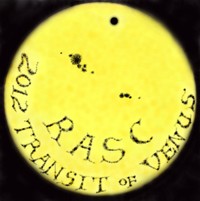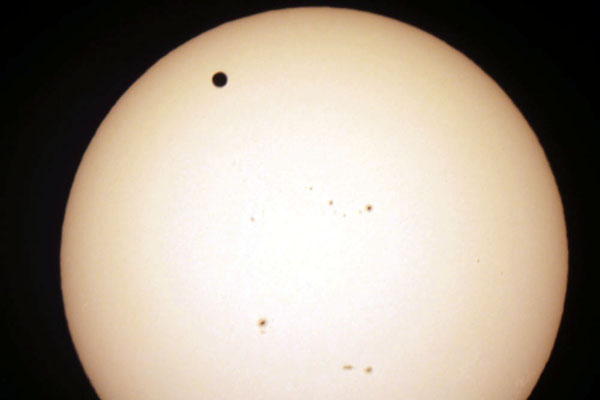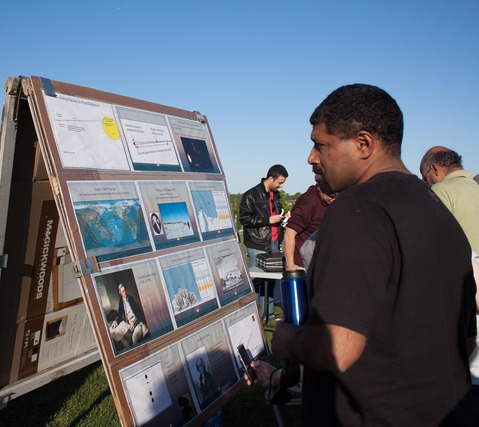 The 2012 June 5-6 transit of Venus (ToV) is over, and there won't be another one till 2117! Many RASC members successfully viewed the ToV here and abroad, and you can find the graphic record of the observations―and of the astronomers making them―here.
The 2012 June 5-6 transit of Venus (ToV) is over, and there won't be another one till 2117! Many RASC members successfully viewed the ToV here and abroad, and you can find the graphic record of the observations―and of the astronomers making them―here.
Note: all images are copyright of the attributed photographers and graphic artists, and must not be used without prior permission
Peter Broughton, Toronto Centre
The attached is a photo of the image of the projected sun taken on our back porch at the moment which I judged to mark second contact (6:20:54 EDT). We got the family from next door to come and have a look. They were mildly interested, but the dad was much keener to show me how he could hold his iPad up to the sky and see the event on it, complete with all the surrounding constellations! I can’t vouch for the accuracy of my timing, but if anyone really wants to know how I came up with 6:20:54, I can explain.
Eric Briggs, Toronto Centre




All images are by Eric Briggs, except for the second one, which was taken by Justin Good
Eric writes:
Perhaps a thousand people observed the Transit under initially clear skies at the Ontario Science Centre in Toronto. It's hard for me to judge attendance because for most of the event I was at an observing station on a remote part of the OSC roof, providing a video feed in to the Telus room downstairs for public viewing. The Sun passed behind a cloud after an hour or so of the Transit, at which point the observing station was struck down and we mingled with other visitors. Maria Bloch, Justin Good, Sim Sim, Brenda Shaw and I observed through my 8-inch Celestron SCT which was providing the video feed, and also a Coronado PST, #14 welders' glass, and both the Dunlap Institute and Rainbow Symphony Transit viewers, which we compared. We should thank Doug Carman, Jesse Rogerson and other Science Centre staff for inviting us to set up there.
The roof was not the best observing site, although it was a special opportunity just to be there and shoot video on behalf of everyone downstairs. The flagstones on the roof were not properly isolated, so moving around the roof caused the image to jump. The roof surface was quite hot, so seeing was not great. Brenda led us in hoping we could observe the Lomonosov Ring, but we all missed this effect. Given the rareness of trying to observe this "ring of fire", we're pretty sure we can console ourselves by observing Venus's crescent cusp extensions the next time the planet approaches inferior conjunction again in 580 days. Cellphone reception on the roof was good, allowing me to do a quick on-air interview with CFRB radio during the event.
I provided the video feed like this: My 8-inch Celestron's original 40mm Plossl eyepiece provided a full-frame view of the Sun to my Canon camcorder, attached to the eyepiece with a ScopeTronix thread-in adaptor. This allowed the camera to zoom and the telescope to scan across the Sun, once the computerized telescope's Sun safety warning was temporarily switched off. The Celestron 'Solar System Align' mode allowed a good alignment by just sighting the telescope towards the Sun with Kendrick full-aperture solar filter installed, and selecting 'Venus' from the Solar System Alignment. A shortwave radio in the background provided a WWV time signal.
I used a broadly similar set-up to record the Transit in 2004, when I was personally satisfied to time the Third Contact to within 15 seconds. The bad seeing and vibrations this year reduced my accuracy of timing Second Contact significantly.
Doug Carman brought us an ancient copy of the RASC Toronto Centre's 'SCOPE' newsletter centennial issue from 1968, which described the aftermath of the December 6, 1882 Transit in Toronto (which was clouded out.)
Dr. John Moores, who was preparing to do a lecture downstairs at the conclusion of the evening, joined us just before the clouds moved in. After all the equipment was carried downstairs and packed away, we visited the main RASC observing sites in the Teluscape forecourt and the north parking lot of the Science Centre. These sites are often used for RASC star parties, going back more than two decades to the planetary conjunction of June 14, 1991 when I recall more than a thousand people showed up. Brenda bumped into Prof. Caldwell, one of her instructors from her time at York University's astrophysics department. Paul Delaney at York University had set up another Transit station at the Keele Campus with webcasting through their 'yorkobservatory.com' portal.
Before the cloudy sunset, I got to meet David Makepeace, a well-known Torontonian eclipse chaser, with others set up in the north parking lot with a variety of equipment. None of it was any use any more and there was at least one young observer in tears, who arrived after the clouds. We pointed her to jump on the Internet to see the conclusion of the Transit, which was never on the cards for us anyways.
Leslie Strike, Mississauga Centre




images by Randy Attwood, Val and Allan Connery, and Thomas Bernard
Leslie writes:
The weather was iffy until late in the day, but the clouds cleared and we were blessed with sunny skies until well into sunset. Over 1000 people came out to look at the event through about 15 scopes that the Centre had set up on the campus of the University of Toronto @ Mississauga. It was a real picnic atmosphere with blankets on the grass and people chatting while lining up to see the transit through the different scopes. We had a good number of families with young kids there, as well as many teenagers and young adults. For many, it was their first look through a telescope, and we heard lots of "wow"s.
Quite a few people remained after the eclipse to get a glimpse of Saturn, Mars and the Moon through the clouds.
All in all, a great success!
Carl Roussell, Hamilton Centre

- Log in to post comments
